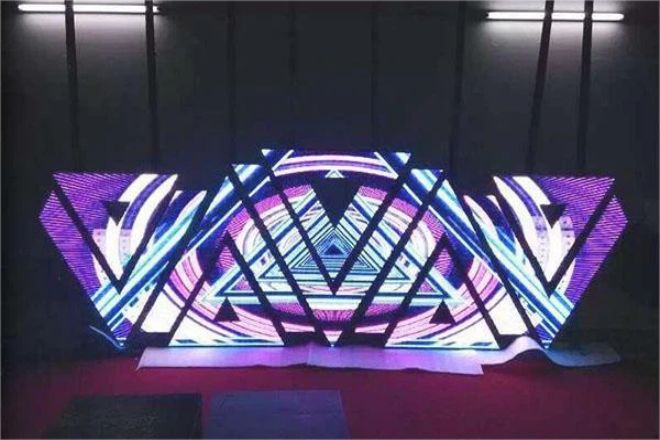介绍

在数字化时代的浪潮中, LED显示屏 已不再仅仅是信息传播的工具,更是创造力与科技的结晶,更是连接现实与梦想的桥梁。
从传统的平面显示到如今的多元化、个性化显示,LED显示屏正以前所未有的速度不断演进,其中,突破传统的LED显示屏更是凭借独特的形态、优异的性能、广泛的应用场景,成为视觉艺术领域一颗璀璨的新星。
这些标新立异的LED显示屏或如丝绸般柔滑可塑,或如空气般通透,与周围环境融为一体,或形态各异,挑战我们对“屏幕”的传统认知,更有超高清微间距的佳作,将细节之美展现得淋漓尽致。
它们不仅给广告、娱乐、艺术等领域带来了革命性的变化,而且深刻影响了我们的生活方式和审美观念。
1、什么是非常规LED显示屏?
非常规LED显示屏是指在设计、形态、应用领域或技术特性上超出传统标准LED显示屏范围的显示设备。传统LED显示屏通常是指由平面、矩形的LED显示单元按一定的像素间距排列构成的屏幕,主要应用于户外广告、室内信息显示等场景。
非传统LED显示屏则突破了这些常规的限制,具有以下一个或多个特点:
- 形式多样化:
非常规LED显示屏不再局限于平面、矩形等形态,可以采用柔性、可弯曲、透明、球形、圆柱形、弧形、波浪形等异形设计,这种多样性使得LED显示屏能够更好地适应各种复杂或特殊的安装环境,实现更加个性化、富有创意的显示效果。
- 技术进步:
非常规LED显示屏往往采用更加先进的技术和材料,如微间距技术、高亮度LED芯片、高刷新率控制系统等,以实现更高的分辨率、更宽的视角、更流畅的显示效果、更低的功耗。这些技术使非常规LED显示屏的画质、稳定性、可靠性等有了显著的提升。
- 应用广泛:
由于表现形式和技术的多样性,非常规LED显示屏在应用领域也得到更加广泛的应用,不仅用于传统的广告、信息显示,还逐渐渗透到舞台演出、体育赛事、主题公园、艺术展览、建筑装饰等诸多领域,为这些场景带来前所未有的视觉体验。
- 定制服务:
非常规LED显示屏通常需要根据特定的应用场景和需求进行定制,包括屏幕尺寸、形状、分辨率、亮度、色彩等参数的调整,以及安装结构、控制系统、内容播放软件等配套服务,因此定制化服务成为非常规LED显示屏市场的一大特点。
2、非常规LED显示屏最常使用的场景

非常规LED显示屏因其形式独特、技术先进、应用范围广泛等特点,被越来越多地应用于各种场景。根据目前的信息,以下是使用最多的场景:
1). 阶段 演出及活动:
- 背景墙及装饰:
LED显示屏已成为演唱会、文艺演出、展览会等场合的标配。
可以呈现精美的背景画面、动态效果、视觉效果,增强现场气氛和观看体验,高分辨率、高色彩还原、高可视度使得LED显示屏成为舞台表演的重要组成部分。
- 互动设备:
在一些创意展览、艺术活动中,非常规的LED屏幕被用作互动设备,通过触摸、感应等方式与观众互动,提供独特的参与感和体验感。
2).商业中心及广告展示:
- 异形广告牌:
在商业中心、购物中心等公共场所,标新立异的LED屏幕以独特的造型和创意设计吸引人们的目光,可以是球形、圆柱形,也可以是其他异形设计,给广告带来新鲜感。
- 透明窗口:
透明LED屏广泛应用于商店橱窗展示,可同时显示店内商品和背景图像,营造虚实结合的视觉效果,提升品牌形象和购物体验。
3).建筑幕墙及装饰:
- LED屏+建筑幕墙:
此组合已在多个城市推广,LED屏不仅具备节能照明功能,还能起到宣传传递信息的作用,应用于城市地标建筑、市政建筑、商业街等场所,成为城市夜景的重要组成部分。
- 创意装饰:
非常规的LED屏幕也经常用于建筑物的外部装饰或内部空间装饰,通过动态的图像和色彩变化营造出独特的氛围和视觉效果。
4). 运动的 体育场:
- 环形幕布和中心悬挂幕布:
在体育场馆中,非常规LED显示屏以环形屏或中央吊屏等特殊形式显示比赛信息、赛事直播或广告内容,可提供全方位的视觉体验,满足观众的观看需求。
- 定制解决方案:
由于体育场馆特殊的空间和结构,非常规LED显示屏的定制化要求较高,厂商需要根据场馆的实际情况,提供量身定制的解决方案。
6).其他领域:
- 交通诱导:
在高速公路、桥梁、隧道等交通枢纽处,非常规LED显示屏可以实时显示道路状况、车辆通行指示等,提高交通运行效率。
- 信息发布:
在学校、医院、银行、酒店等公共场所,非常规LED显示屏可以发布各类信息,如通知、公告、新闻等,提供及时、准确的信息服务。
需要注意的是,以上场景只是非常规LED显示屏应用的一部分,随着技术的不断进步,市场的不断扩大,非常规LED显示屏的应用领域还会不断扩大。
同时,由于不同场景的需求和条件不同,非常规LED显示屏的定制服务将变得越来越重要。
3、非常规LED显示屏与传统LED显示屏的区别
非常规LED显示屏与传统LED显示屏存在着显著的差异,主要体现在形态设计、技术特点、应用场景、用户体验等方面,下面就这些差异进行详细分析:
1). 表单设计
1.1).传统LED显示屏:
标准形式:通常是扁平的矩形结构,像素按固定间距排列。
固定安装:安装位置比较固定,不易改变形状或尺寸。
1.2).非常规LED显示屏:
形态多样化:可为柔性、透明、球形、圆柱形、弧形、波浪形、等异形设计。
定制化:根据具体的应用场景和需求进行定制化设计,如屏幕尺寸、形状、分辨率、亮度等参数的调整。
2). 技术特点
2.1).传统LED显示屏:
标准技术:采用成熟的LED显示技术,显示效果稳定,使用寿命长。
灵活性有限:点距、亮度、色彩等方面受到一定限制,难以满足所有特殊需求。
2.2). 非常规LED显示屏:
技术先进:往往会采用较为先进的技术和材料,例如微间距技术、高亮度LED芯片、高刷新率控制系统等。
灵活性高:在分辨率、亮度、色彩、视角等方面具有更高的灵活性和可调性,可满足更多特殊需求。
3). 应用场景
3.1).传统LED显示屏:
适用范围广:适用于户外广告、室内信息显示、体育场馆等场景。
标准化应用:更多应用于需要标准尺寸、显示效果的场合。
3.2).非常规LED显示屏:
应用多样化:不仅适用于传统场景,还广泛应用于舞台表演、商业展览、建筑装饰、交通诱导等需要特殊形式和创意设计的场合。
创意展示:通过独特的形式、富有创意的设计,给观众带来全新的视觉体验。
4). 用户体验
4.1).传统LED显示屏:
稳定可靠:提供稳定可靠的显示效果,满足基本的观看需求。
交互性有限:交互性和用户体验相对有限。
4.2). 非常规LED显示屏:
增强沉浸感:通过异形设计、动态画面,增强观众的沉浸感和参与感。
增强吸引力:独特的视觉效果和高度的灵活性可以吸引更多观众的注意力和兴趣。
4.如何使用它们才能达到最佳效果?

为了使非常规LED显示屏达到最佳效果,可以遵循以下建议:
1). 前期准备
1.1).明确应用场景及需求:
根据具体的应用场景(如舞台演出、商业展览、建筑装饰等)和要求(如尺寸、形状、分辨率、亮度等)选择合适类型的非常规LED显示屏。
1.2). 专业设计定制:
与专业LED显示屏厂家或设计公司合作进行定制化设计。确保设计方案符合应用场景的特点和要求,同时兼顾安装、调试、维护的便捷性。
1.3).保证电压、电流的稳定性:
电子产品最怕电压、电流不稳定,对LED显示屏的影响会非常大,所以使用前要保证电源电压、电流的稳定,避免瞬间的尖峰损坏显示屏。
2).安装调试
2.1).正确安装:
按照设计方案及厂家提供的安装指南进行安装,确保显示屏安装牢固、平整,连接线正确。
2.1). 调试与测试:
安装完成后进行调试测试。检查显示屏的显示效果、亮度、色彩、对比度等参数是否符合要求。同时确保控制软件和播放设备能正常工作并与显示屏实现无缝对接。
2.3).避免灰尘和潮湿:
在安装调试过程中,应注意避免灰尘、湿气对显示屏的影响,若环境中灰尘较多或者湿度较大,应采取适当的防尘、防潮措施。
3).使用与保养
3.1). 标准操作:
使用过程中,应遵循正确的操作程序和安全规定。
例如开关机时要遵循先开屏后开机,先关机后关屏的顺序;避免在全白屏状态或者失控状态下开屏。
3.2).定期保养:
定期对显示屏进行维护与保养,包括清洁屏体、检查连接线、调整参数等,有助于延长显示屏的使用寿命、提高显示效果。
3.3.). 预留休息时间:
LED显示屏虽然可以长期使用,但也需要适当的休息,特别是长时间连续使用后,应关闭显示屏,让其休息一会儿,以免显示屏过热损坏。
3.5).注意环境因素:
使用过程中,应注意环境因素对显示器的影响。例如,避免在雷雨天使用显示器;在高温或低温环境下使用时,应注意散热或保温;在强光照射下,应注意调节亮度和对比度等。
- 专业维护:
如果显示屏出现故障或损坏,应尽快联系专业维修人员进行维修或更换,避免自行拆卸或维修,以免造成更大的损坏或安全隐患。
- 创意与内容创意设计:
利用非常规LED显示屏的独特形式和特性进行创意设计。通过动态图像、色彩变化、互动效果等增强观众的视觉体验和参与感。
优质内容:准备优质播放内容,内容要符合应用场景,有吸引力、有感染力,同时注意内容的更新替换,保持观众的新鲜感和兴趣。
结论
随着科技的不断进步,创意的无限涌现,标新立异的LED显示屏正以前所未有的速度改变着我们的视觉体验,它不仅仅是科技的展示,更是艺术与科技的完美融合,是时代精神的体现。
最后,如果您想了解更多关于LED显示屏的知识, 请与我们联系。
